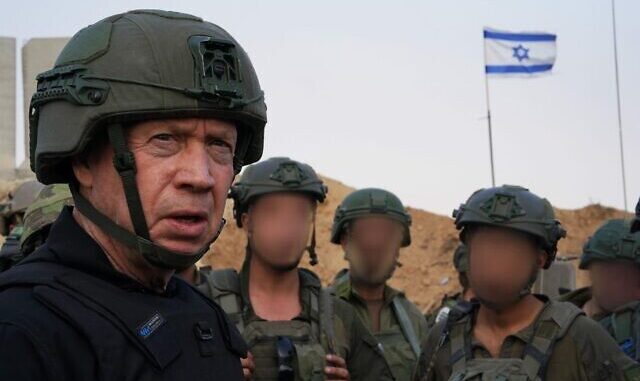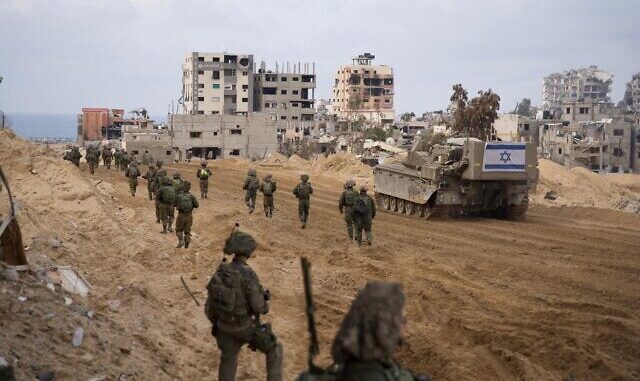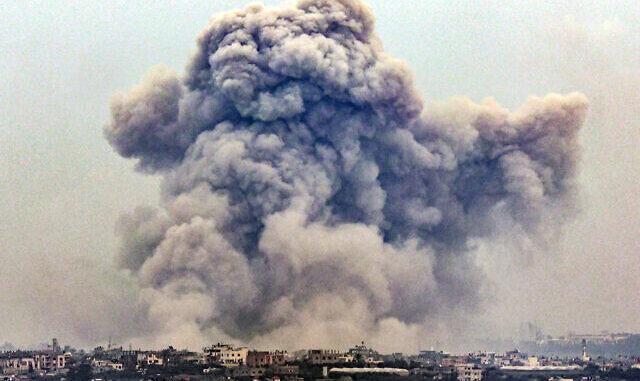Defense minister says Hamas battalions in northern Gaza ‘destroyed,’ fighting in Strip’s south to remain at ‘high intensity’ until goals achieved; Staff Sgt. Sufian Dagash killed
By EMANUEL FABIAN, TOI 2 January 2024, 9:52 pm

Defense Minister Yoav Gallant is seen with IDF troops in the central Gaza Strip, January 2, 2024. (Ariel Hermoni/Defense Ministry)
His comments came a few hours before top Hamas official Saleh al-Arouri was killed in a blast in Beirut widely attributed to Israel.
Gallant’s remarks were made during a tour of the Strip’s main north-south highway, Salah a-Din road, in the central Gaza Strip, where the 99th Division has been operating over the past week.
“You are in the ‘corridor,’” Gallant said to troops of the division’s 646th Reserve Paratroopers Brigade. “On both your sides, operations of a different kind will soon take place.”
“To the north, we destroyed 12 Hamas battalions. Terrorists still remain, a few thousand of the 15,000 or 18,000 that were in the area. A large number of them were eliminated and others fled to the south,” Gallant said.
In northern Gaza, Gallant said, the IDF would continue to conduct smaller operations to root out the last Hamas operatives. “The goal is to exhaust the enemy, kill [its operatives], and achieve a situation in which we control the territory,” he said.
On Sunday, the IDF said it was withdrawing five brigades from Gaza — three brigades usually tasked with training other forces and two reserve brigades — but said the war against Hamas would likely last throughout all of 2024.
He was named as Staff Sgt. Sufian Dagash, 21, of the Combat Engineering Corps 601st Battalion, from Maghar.
Another officer, soldier and reservist soldier of the 601st Battalion were seriously wounded in the same incident, the IDF said.
He said the IDF was focused on infrastructure above Hamas tunnels in the Khan Younis area “where senior Hamas officials are hiding, at great depths.”
“We are reaching them… and it is happening already now,” Gallant said.
He said the fighting in southern Gaza would remain at “high intensity.”
“The results will be clear results,” Gallant vowed. “We will end this campaign when Hamas does not function as a governing body and certainly not as a military body… It will take time,” he said.
Gallant added that “at the same time, unfortunately, there are other threats, the first and most prominent of which is what is happening in the north,” referring to daily attacks by Hezbollah from Lebanon.
Fighting inside the tunnels
In northern Gaza, the IDF announced Monday that troops recently captured a Hamas stronghold in Gaza City’s Sheikh Radwan neighborhood, with special forces battling terror operatives inside tunnel networks beneath the site.
Hamas’s so-called Eastern Outpost was made up of 37 buildings “in the heart of the civilian population,” surrounded by residential buildings, a school and a hospital, with a mosque in the complex used as a meeting point for Hamas operatives, according to the IDF.
It said the “strategic” stronghold was used by Hamas’s intelligence division and other units of the terror group to “manage the fighting in the entire Gaza Strip.”
It said the bunker had resting areas for Hamas commanders to remain hidden for long periods. Troops also found weapons and other equipment inside the underground hideout.
In other areas of the stronghold, the IDF said troops of the Givati Brigade’s Shaked Battalion located five tunnel shafts, each of them dozens of meters deep, which all connected via an underground network. The IDF said the tunnel network also connected to the main underground bunker.
Forces of the Israeli Air Force’s elite Shaldag unit entered one of the tunnels and battled Hamas gunmen underground, the IDF said, adding that “at the end of the fighting, all the terrorists were eliminated.”
The tunnel network was later destroyed by the Combat Engineering Corps’ 601st Battalion and elite Yahalom unit.
Also during the operation, troops of the 401st Brigade’s 52nd Battalion raided another building in the Eastern Outpost, where they encountered Hamas gunmen who opened fire at them from the upper floor, the IDF said.
![]()

The IDF said the troops engaged the Hamas gunmen while working to evacuate wounded soldiers under fire. The gun battle then expanded to other areas of the stronghold.
All the Hamas gunmen were killed in the battle, according to the IDF, along with three Israeli soldiers of the Shaked Battalion: Lt. Yaron Eliezer Chitiz, Staff Sgt. Itay Buton and Staff Sgt. Efraim Jackman, whose deaths were announced last week.
Also in Gaza City, the IDF said troops of the 460th Armored Brigade recently raided the home of Hamas’s Gaza City Brigade commander in the area of the Daraj and Tuffah neighborhoods, where troops found weaponry and infrastructure.
It said that during fighting over the area, troops encountered and killed dozens of Hamas gunmen, and located tunnel shafts, caches of weapons and intelligence materials.
According to the IDF, intelligence findings found in the area indicated that the main mosque in the Daraj and Tuffah neighborhoods was used by Hamas as part of its October 7 onslaught on southern Israel. It did not offer further details.
The home of the Hamas commander was later destroyed.
South of Gaza City, the IDF said the 99th Division’s 179th Reserve Armored Brigade spotted three Hamas men entering a building known to be used by the terror group.
An IAF fighter jet struck the building, killing the terror operatives inside. The IDF said several secondary blasts were seen, indicating the building had been used as a weapons depot.
Also in central Gaza, the 646th Brigade found a Hamas weapons lab and underground long-range rocket launchers, the IDF said.
In central Gaza’s al-Bureij, the IDF said troops of the 188th Armored Brigade and Golani Infantry Brigade located long-range rockets among other weapons in residences.
In the home of a Palestinian family, the 188th Brigade found a cache of rockets capable of being launched to distances of 20 kilometers. Other weapons were found in the home, according to the IDF.
In another home in al-Bureij, Golani soldiers found dozens of mortars and short-range rockets, along with other weapons.
The rockets were destroyed and the other weapons were seized, the IDF said.
In another area of al-Bureij, Golani troops located a number of rockets that were hidden near a UNRWA school, the IDF said.
Overnight, the IDF said Navy forces and ground troops identified Hamas operatives planting explosive devices along the coast and nearby buildings.
It said the Navy, IAF and ground troops struck and killed the gunmen and destroyed the explosives.
In southern Gaza’s Khan Younis, the IDF said the Paratroopers Brigade attacked several Hamas sites and raided apartments where Hamas stored weapons.
While the IDF has indicated ground operations are slowing down in northern Gaza, it said that troops of the 261st Brigade (the Bahad 1 officers’ school during wartime) had killed dozens of Hamas operatives in the Jabaliya area. The brigade is one of the five that are being withdrawn from the Strip.
The IDF said some of the operatives were attempting to plant explosives, some were operating drones, and others were armed and driving toward the troops.
In the last few weeks, as the IDF has expanded its ground offensive in Gaza and gained control of much of the ground in the northern part of the Strip, the rate of rocket fire on Israel has slowed significantly.
On Monday, after a lull of nearly 42 hours, rockets were fired from Gaza at the border city of Sderot. There were no reports of injuries or damage.
Israel’s ground operation in Gaza followed three weeks of aerial bombardments in the wake of the Hamas-led massacres on October 7, when Palestinian terrorists stormed the border into southern Israel and killed some 1,200 people — mostly civilians — and kidnapped at least 240.
Israel declared war on Hamas in response, launching an offensive aimed at toppling the Gaza-ruling terror group and securing the release of the hostages. The ground operation initially concentrated on northern Gaza but has since expanded to the Strip’s south.

It is believed that 129 hostages abducted by Hamas on October 7 remain in Gaza — not all of them alive — after 105 civilians were released from Hamas captivity during a weeklong truce in late November. Four hostages were released prior to that, and one was rescued by troops. The bodies of eight hostages have also been recovered and three hostages were mistakenly killed by the military. The IDF has confirmed the deaths of 23 of those still held by Hamas, citing new intelligence and findings obtained by troops operating in Gaza.
Another three people are listed as missing since October 7, and their fates are still unknown.
Hamas is also holding the bodies of fallen IDF soldiers Oron Shaul and Hadar Goldin since 2014, as well as two Israeli civilians, Avera Mengistu and Hisham al-Sayed, who are both thought to be alive after entering the Strip of their own accord in 2014 and 2015 respectively.
The Hamas-run health ministry in Gaza has claimed that since the start of the war, more than 22,000 people have been killed, mostly civilians. However, these figures cannot be independently verified and are believed to include some 8,500 Hamas fighters, as well as civilians killed by misfired Palestinian rockets. Another estimated 1,000 terrorists were killed in Israel during the October 7 onslaught.



Leave a Reply
You must be logged in to post a comment.